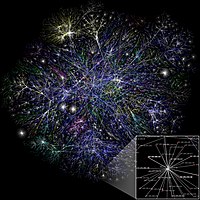
Photo from wikipedia
We compare two versions of the nonlinear q-voter model: the original one, with annealed randomness, and the modified one, with quenched randomness. In the original model, each voter changes its… Click to show full abstract
We compare two versions of the nonlinear q-voter model: the original one, with annealed randomness, and the modified one, with quenched randomness. In the original model, each voter changes its opinion with a certain probability ϵ if the group of influence is not unanimous. In contrast, the modified version introduces two types of voters that act in a deterministic way in the case of disagreement in the influence group: the fraction ϵ of voters always change their current opinion, whereas the rest of them always maintain it. Although both concepts of randomness lead to the same average number of opinion changes in the system on the microscopic level, they cause qualitatively distinct results on the macroscopic level. We focus on the mean-field description of these models. Our approach relies on the stability analysis by the linearization technique developed within dynamical system theory. This approach allows us to derive complete, exact phase diagrams for both models. The results obtained in this paper indicate that quenched randomness promotes continuous phase transitions to a greater extent, whereas annealed randomness favors discontinuous ones. The quenched model also creates combinations of continuous and discontinuous phase transitions unobserved in the annealed model, in which the up-down symmetry may be spontaneously broken inside or outside the hysteresis loop. The analytical results are confirmed by Monte Carlo simulations carried out on a complete graph.
Journal Title: Chaos
Year Published: 2020
Link to full text (if available)
Share on Social Media: Sign Up to like & get
recommendations!